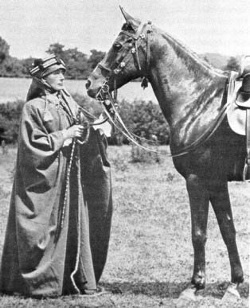Strain of the Week: Kuhaylan al-Wati — famous relatives
According to the Abbas Pasha Manuscript, sometime in the first half of the nineteenth century, a Bedouin warrior by the name of Rashid ibn Jarshan, from the tribe of al-Buqum, owned a branch of the strain of Kuhaylan al-‘Ajuz that was known as Kuhaylat Ibn Jarshan, after his name. His marbat was famous, and one of his mares was even the subject of a Bedouin ode. Ibn Jarshan sold one of his Kuhaylat mares, a grey by the name of al-Shuhaybah, to another Bedouin, Sarhan al-‘Abd of the tribe of al-‘Ajman.
The strain of Kuhaylan Ibn Jarshan seems to have prospered at al-‘Abd, because al-Shuhaybah produced a grey daughter for him (by a Saqlawi), and that daughter in turn produced a grey daughter (also by a Saqlawi). Al-‘Abd leased the latter, the grand-daughter of Ibn Jarshan’s Kuhaylah, to a third Bedouin, Ibn Jallab of the tribe of Aal Murrah. She stayed at Ibn Jallab for six years without producing any foals, so al-‘Abd took her back by force, and sold her to Ibn Khalifah of Bahrain for a ton of money, plus camels, falcons, clothes, a slave (!) and a sizeable bunch of dates, a sale that effectively turned him (al-‘Abd) into a precursor of today’s Gulf millionnaires..
Her short and unproductive stay at Ibn Jallab would have been of no consequence whatsoever, weren’t it for a small detail: when al-‘Abd took his Kuhaylat Ibn Jarshan back, he gave her a name, a nick name: al-Jallabiyah, after the man he had briefly leased her to. Al-‘Abd did not seem to be the kind of man who holds grudges for a long time.. When Ibn Khalifah of Bahrain bought the same al-Jallabiyah from al-‘Abd, she became his foundation mare, and as her descendents’ fame skytocketed, she founded a strain of her own: Kuhaylan Jellabi or Jallabi. The rest is history.
You can read the entire story here, but what I want to highlight is the following:
First: Ibn Jellab never owned a marbat of his own, never obtained any foals from the mare he leased for six short years, is the least important person in this story, yet he is world famous. Why? Because someone else name a mare after him.
Second: Kuhaylan Jallabi is just another name for Kuhaylan Ibn Jarshan, since the mare known as al-Jallabiyah was the granddaughter of Ibn Jarshan’s own mare al-Shuyhaybah [hence the somewhat provocative title of the photo below, put your mouse’s pointer on it].
Third, and most important for our purposes here: re-read the story carefully, until you get to the fifth line of the fourth paragraph: “She has relatives at Ibn Jarshan’s”.
With this in mind, stay tuned for the next episode.

The strain of Kuhaylan Ibn Jarshan
it was Before Rashid bin Jarshan Owned by Bani Hajer Al-Qahtani tribe
and Kuhaylan Ibn Jarshan her Daughter alhanifa and alhanifa has Daughter the Name alZhia she Was with my tribe.
and alhanifa change the Name with Al Murrah tribe to Jullabi
Note alAbd is from Ajman tribe
Quote from Lady Anne Blunt’s Journals, December 13, 1883, in Bombay:
“Abdur Rahman showed us a promising colt he had bought, a Keh. el Wati 2 years dark bay no white — well grown — (minjemaat Jedaan). He means to name him Faris.”
Indeed Keh. el Wati is from the Sba’ah ‘Anazah, of which Jad’aan ibn Mhayd (who is from the Fad’aan) was commanding at the time.
According to the tribal histories of al-Buqum (al-Bugum), Rashid Ibn Jarshan, the leader of the Karzan clan of al-Buqum led the tribe in its war against the Ottomans and the Egyptians in Safar 1229 H; this was when the Egyptian army, supported by Bedouins from Libya (no doubt the Hanadi) attacked the Buqum’s principal strongold of Turabah, but were repelled.
[Edouard note: the role of Ibn Jarshan as the leader of the second Buqum battle needs to be verified]
If you dig further in to the tribe’s structure, you will find the family of al-Jarashin (the people of Jarshan, in the plural), within the clan of al-Shluhah, within the section of al-Karzan within the tribal section of al-Mahamid, which is one of the sub-groups of the Buqum tribe.